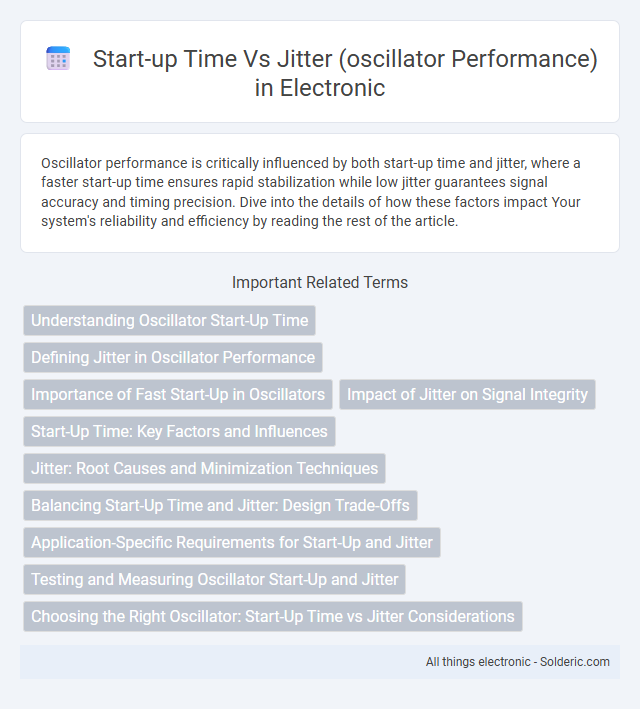Oscillator performance is critically influenced by both start-up time and jitter, where a faster start-up time ensures rapid stabilization while low jitter guarantees signal accuracy and timing precision. Dive into the details of how these factors impact Your system's reliability and efficiency by reading the rest of the article.
Comparison Table
| Parameter | Start-up Time | Jitter |
|---|---|---|
| Definition | Time taken for an oscillator to stabilize at the desired frequency after power-up | Short-term variations in the oscillator's signal period or phase |
| Measurement | Seconds or milliseconds to reach frequency stability | Usually measured in picoseconds (ps) or femtoseconds (fs) |
| Impact | Affects system initialization and timing accuracy during startup | Degrades signal integrity, causing timing errors in digital communication |
| Optimization | Design circuits for quick frequency lock and minimize warm-up delay | Use low-noise components, phase-locked loops (PLL), and signal filtering |
| Typical Values | Microseconds to milliseconds (varies by oscillator type) | Sub-picosecond to a few picoseconds RMS |
| Common Applications | System boot-up, frequency synthesizers, clock generators | High-speed communication, precision timing, data converters |
Understanding Oscillator Start-Up Time
Oscillator start-up time is the duration required for an oscillator to reach a stable frequency and amplitude after power-up, directly impacting jitter performance and signal integrity in communication systems. Shorter start-up times reduce phase noise and timing uncertainty, enhancing the precision of your timing circuits in applications like high-speed data transmission and frequency synthesis. Optimizing oscillator start-up time ensures consistent oscillator performance, minimizing jitter and improving overall system reliability.
Defining Jitter in Oscillator Performance
Jitter in oscillator performance refers to the small, rapid variations in timing of the oscillator's output signal, which can degrade signal integrity and impact system reliability. Start-up time is the duration an oscillator takes to reach a stable operating frequency, during which jitter levels may be elevated before settling into predictable performance. Understanding jitter characteristics is essential for optimizing your oscillator choice to ensure precise timing in applications like communications and data conversion.
Importance of Fast Start-Up in Oscillators
Fast start-up time in oscillators is critical for applications requiring immediate signal stabilization, directly impacting overall system reliability. Lower start-up durations reduce transient errors and improve synchronization accuracy, particularly in communication and timing-sensitive devices. Optimized oscillator designs balance start-up speed with phase noise and jitter performance to ensure precise, stable output signals.
Impact of Jitter on Signal Integrity
Jitter in oscillator performance directly affects your signal integrity by causing timing variations that degrade data transmission accuracy. Excessive jitter introduces phase noise and timing errors, leading to increased bit error rates and system instability in high-speed communication. Minimizing jitter during start-up time ensures reliable synchronization and optimal oscillator function for precise signal generation.
Start-Up Time: Key Factors and Influences
Start-up time in oscillator performance is primarily influenced by the quality factor (Q) of the resonator and the drive level applied during initial excitation. Lower Q values or insufficient drive levels can increase the time required for the oscillator to achieve a stable output frequency, directly impacting jitter characteristics. Understanding these factors helps you optimize oscillator design for faster start-up and reduced phase noise jitter.
Jitter: Root Causes and Minimization Techniques
Jitter in oscillator performance primarily arises from phase noise, supply voltage variations, and temperature fluctuations, causing timing uncertainty that impacts signal integrity. Minimizing jitter involves optimizing the oscillator design with low-noise components, implementing robust power supply regulation, and employing temperature-compensated crystal oscillators (TCXO) or oven-controlled crystal oscillators (OCXO) for stable frequency output. Your system reliability improves significantly when these techniques reduce jitter, ensuring precise timing crucial for high-performance applications.
Balancing Start-Up Time and Jitter: Design Trade-Offs
Balancing start-up time and jitter in oscillator performance involves carefully optimizing circuit parameters to minimize initialization latency without compromising signal stability. Lowering start-up time often increases jitter due to insufficient stabilization, while reducing jitter typically requires longer start-up intervals to achieve steady oscillation conditions. Designers must evaluate application requirements to select appropriate trade-offs between rapid synchronization and phase noise reduction in timing-sensitive systems.
Application-Specific Requirements for Start-Up and Jitter
Start-up time and jitter in oscillators critically impact application-specific performance, where shorter start-up times enable rapid device readiness in communication systems and real-time processing. Low jitter ensures signal integrity and timing accuracy essential for high-speed data transmission, radar, and precision instrumentation. Tailoring oscillator specifications to balance start-up latency and phase noise meets the stringent demands of each application's operational environment.
Testing and Measuring Oscillator Start-Up and Jitter
Testing and measuring oscillator start-up time involves capturing the interval from power application to stable oscillation, using high-speed oscilloscopes or time-domain analyzers to ensure precise timing analysis. Jitter performance is quantified by assessing phase noise and timing variations with spectrum analyzers and phase noise measurement systems, focusing on short-term and long-term stability. Accurate characterization requires synchronized measurement setups and statistical evaluation to distinguish intrinsic oscillator noise from environmental disturbances.
Choosing the Right Oscillator: Start-Up Time vs Jitter Considerations
Selecting the right oscillator for your application requires balancing start-up time and jitter performance to meet system requirements. Oscillators with fast start-up times enable quicker system readiness but may exhibit higher phase noise, affecting jitter and timing accuracy. Your optimal choice depends on whether minimizing initial delay or ensuring low jitter is more critical for reliable oscillator performance in your design.
Start-up time vs Jitter (oscillator performance) Infographic

 solderic.com
solderic.com